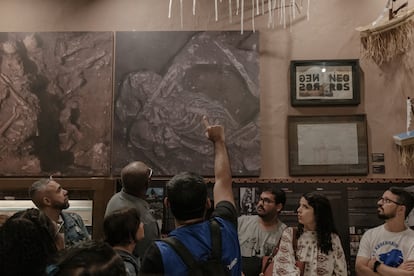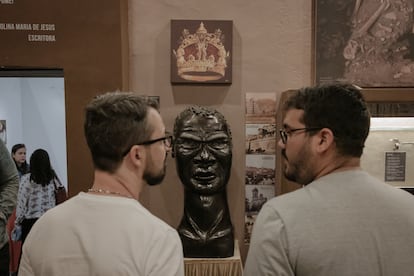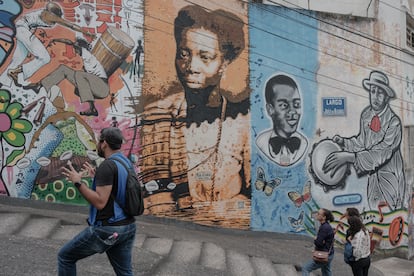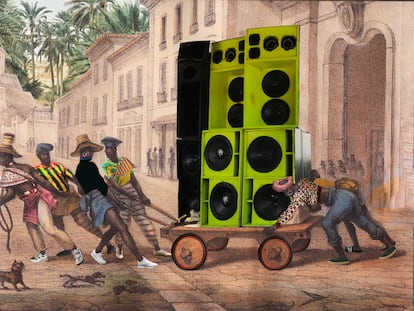Brazil embraces ‘Afro-tourism’
The government is exploring this new market and pledges to support small Black entrepreneurs in this sector

Every weekend, the group grows larger, driven by word of mouth, as more and more people converge at the statue of Mercedes Baptista, a pioneering Black dancer at Rio de Janeiro’s Municipal Theater. The spot marks the starting point of the African Heritage Walking Tour that winds through the heart of Little Africa in central Rio, where hundreds of thousands of enslaved Africans first arrived in Brazil, and where the vibrant rhythms of samba were born in the back alleys.
“Brazilians know the untold history of Black people in this city and the whole country. This is a tourism experience that goes way beyond the usual sights like Rio’s Sugarloaf Mountain and Christ the Redeemer,” said Rafael Moraes, a tour guide from the Institute of Research and New Black Memory (Instituto dos Pretos Novos – IPN). The walking tour ends at a small residence that houses the IPN’s museum and offices. During the house’s renovation, human bones were unearthed from an unmarked cemetery for slaves who perished during the long ocean crossing.
In front of a glass case containing a skeleton, Moraes gives the final talk of the tour, connecting Brazil’s painful past with the daily lives of Black Brazilians who still feel the impacts of racism. Several visitors tear up as he talks. “I think this tour evokes some feelings of guilt – it changes people,” he said. In 2019, almost 2,500 individuals took this tour. This year, it’s projected to reach 15,000. The majority are Rio residents and Brazilians from other states, but every now and then a foreigner joins the tour. The IPN team is actively working on offering multilingual tours for this “afro-tourism” experience, a growing part of Brazil’s tourist industry.
Brazil has the largest Black population outside of Africa, with 56% identifying as Black or mixed race. Interest in the history of Brazil’s Black culture is increasing, particularly in countries where the Black population has more purchasing power, like the United States and Europe. Many of these tourists seek unique experiences beyond the conventional offerings.

Carlos Humberto Silva recognized the potential of afro-tourism a few years ago and started Diaspora Black, a company and website that offer a mix of consultancy, tourist packages and an Airbnb-like marketplace for homestays. All the hosts are Black or supporters of the anti-racism movement. The company’s revenues grew by 395% last year and it expects to earn over $800,000 by the end of this year. Interested tourists can learn about plants used in Afro-Brazilian religions like candomblé, or explore music like jongo and maracatú, which have close ties to slave resistance movements. They can also visit quilombos – rural communities of the descendants of escaped slaves.
Community at the center
As Silva talks about the Black community in Brazil, the first red flag appears. He says the threat of gentrification and commercialization is real, and everyone wants to avoid turning afro-tourism into a theme park experience. “When we talk about afro-tourism, it’s all about the community – it sets the tone, decides which stories to tell and chooses the places to visit. It’s not an outsider’s perspective – it’s the community owning and sharing their own narratives. It’s a movement breaking away from the colonialist model of storytelling. Letting the community tell their own stories!” His company also offers courses to train and empower community members as tourist guides.
Another challenge is ensuring that the income generated by this thriving sector benefits those involved. In Salvador de Bahía, the Brazilian city with the highest percentage of residents of African descent (82%), the Inter-American Development Bank (IDB) invested nearly $3 million in the “Salvador, Afro-Capital” project. While it has brought courses, conferences, exhibitions and cultural events to the city, some critics say many of the companies that won bids for the project are controlled by white owners.

There are still many obstacles to overcome. In colonial cities like Ouro Preto and Paraty, tourism often focuses on the beautiful architecture and baroque gold pieces that obscure their slave-owning history. Other significant places are often overlooked, like the Valongo Wharf in Rio where nearly a million slaves first stepped foot in Brazil. Now an archeological site, Valongo Wharf was declared a UNESCO World Heritage Site in 2017, but it doesn’t appear on the city’s tourist maps and has very poor signage.

Leticia Santana specializes in decolonial tourism and believes Brazil – the eternal country of the future – always tends to leave everything for later. She wants the country to hurry up so it doesn’t miss the afro-tourism train, but says it also has to be careful. The country’s economic structure hasn’t changed, so there’s a risk that “Black culture will turn into entertainment.” Santana is the director of the Chez Georges boutique hotels in Maranhão and Rio. “Many of our Black guests tell me, ‘I didn’t know you were Black. I’m really glad, because now I know you’ll understand my needs.’” The fear of experiencing racism is a significant concern when planning a trip. Santana believes that simply “coloring” the photo is not enough and emphasizes the need for structural changes at the social level.
The demand is there, but sometimes the Brazilian government’s response falls short. Embratur, the government tourism promotion agency, promises things will change after four years of neglect during the Bolsonaro administration. There is now a dedicated afro-tourism department that is collecting data to develop a comprehensive picture of the sector, and everyone seems to recognize there’s significant potential for growth. Last year, Brazil ranked fifth in visitor numbers among Latin American countries (3.6 million tourists), trailing Mexico (38.3 million), the Dominican Republic (7.1 million), Colombia (4.4 million) and Argentina (3.8 million).
Next year, São Luís do Maranhão (northeastern Brazil) will host an international afro-tourism meeting. Tania Neres, Embratur’s coordinator for diversity, afro-tourism and Indigenous peoples, says Brazil has a valuable opportunity at hand. “The biggest challenge is to invest in Black entrepreneurs, so they can become strong owners of their own history.” Neres believes afro-tourism also offers Brazil a chance to finally break free from the stereotype of being a sex tourism destination. Even with progress in recent years, this image still affects Afro-Brazilians disproportionately.

Sign up for our weekly newsletter to get more English-language news coverage from EL PAÍS USA Edition
Tu suscripción se está usando en otro dispositivo
¿Quieres añadir otro usuario a tu suscripción?
Si continúas leyendo en este dispositivo, no se podrá leer en el otro.
FlechaTu suscripción se está usando en otro dispositivo y solo puedes acceder a EL PAÍS desde un dispositivo a la vez.
Si quieres compartir tu cuenta, cambia tu suscripción a la modalidad Premium, así podrás añadir otro usuario. Cada uno accederá con su propia cuenta de email, lo que os permitirá personalizar vuestra experiencia en EL PAÍS.
¿Tienes una suscripción de empresa? Accede aquí para contratar más cuentas.
En el caso de no saber quién está usando tu cuenta, te recomendamos cambiar tu contraseña aquí.
Si decides continuar compartiendo tu cuenta, este mensaje se mostrará en tu dispositivo y en el de la otra persona que está usando tu cuenta de forma indefinida, afectando a tu experiencia de lectura. Puedes consultar aquí los términos y condiciones de la suscripción digital.
More information
Archived In
Últimas noticias
Aquilino Gonell, former Capitol sergeant: ‘If it hadn’t been for the police, the US would be a dictatorship’
A hybrid building: Soccer pitch, housing, and a shopping mall
Europe urges Trump to respect Greenland following annexation threats
Science seeks keys to human longevity in the genetic mixing of Brazilian supercentenarians
Most viewed
- Alain Aspect, Nobel laureate in physics: ‘Einstein was so smart that he would have had to recognize quantum entanglement’
- Mexico’s missing people crisis casts a shadow over World Cup venue
- Alvin Hellerstein, a 92-year-old judge appointed by Bill Clinton, to preside over Maduro’s trial in New York
- Why oil has been at the center of Venezuela-US conflicts for decades
- Cuba confirms death of 32 of its citizens in the US attack against Venezuela










































